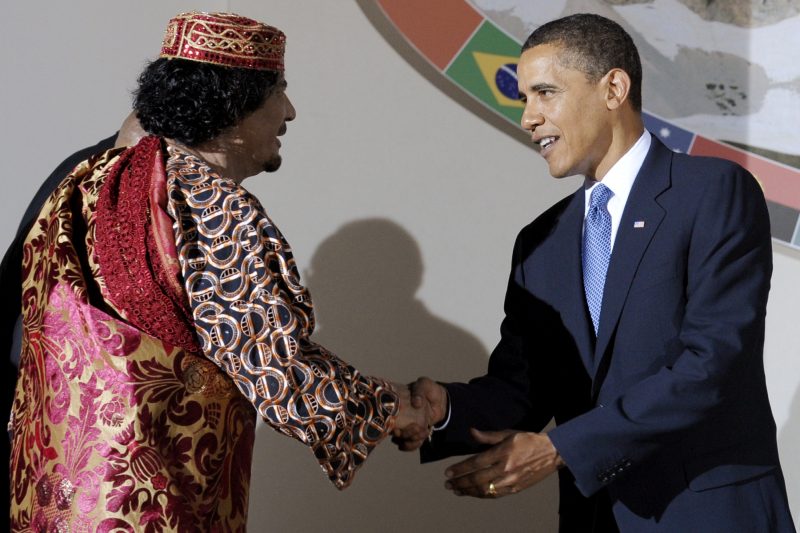Today’s Libya is virtually unrecognizable from Libya of years past. Following the violent ouster of former Libyan leader Muammar Gaddafi in 2011, things have taken a turn for the worse as the north African nation declines further into failure.
One example of Libya’s steep decline has been the proliferation of the illegal arms trade. In 2014, the United Nations named Libya as the primary source of illegal weapons for 14 different countries, fueling a series of international conflicts. More recently, a new report released by the Geneva-based Small Arms Survey has also labeled Libya as an international hotspot for illicit weapon sales, examining thousands of attempted trades.
The Gaddafi regime, prior to losing power, had tightly regulated the domestic arms trade and prevented the illegal sale of weapons. But now, Libya is unable to secure its borders. The weapons market has surged in the years since the 2011 invasion that resulted in Gaddafi’s ouster, as the Libyan government’s weapon stores were looted and quickly fell into the hands of terrorists.
In addition to appearing on online arms markets, weapons from the Gaddafi regime’s arsenal have been found throughout North Africa and the Middle East, particularly in the hands of Daesh (ISIS) militants who are active in Syria and Iraq. Many of these weapons were purchased by the U.S. government and deliberately given to “moderate rebels” in Syria, which – at the time – included the al-Nusra Front, a branch of al-Qaeda that operates in Syria.

In addition, Libya’s geographical location has led to the growth of another illicit industry – sex slavery. With many West African migrants traveling through Libya as they seek passage to Europe, sex slavery has become so commonplace that live slave auctions now occur in plain view of the public, according to a recent statement from the International Organization for Migration. Those not sold into slavery are sometimes thrown in private prisons, where they are held until their families make a ransom payment. Those whose families are unable to pay are taken away and killed, while others have reportedly wasted away from a lack of food and other basic necessities.
Libya still lacks a federal government, which has led to the rise of several warring factions, many of them based on tribal affiliations. Some of the more powerful factions include infamous terrorist groups like Daesh, who, according to U.S. intelligence agencies cited by the New York Times, maintain a presence of some 5,000 fighters in the troubled nation.
Worse still, while U.S. bombings and some armed Libyan factions have reduced Daesh’s power, they have also torn apart the country’s social fabric and set the stage for all-out civil war. In addition, the Italian government recently asserted that Daesh militants are leaving Libya for Europe, posing as wounded Libyan government soldiers.
Libya has also been crippled by constant power blackouts and surging prices for food and other necessities, as well as months of lost salaries for many people who have been put out of work. The situation has deteriorated so much that numerous civilians, many of whom once detested Gaddafi and even fought against his regime in 2011, are lamenting the loss of the nation’s longtime ruler. Tebu Mohammed, a Libyan citizen living in Tripoli, expressed the views of many Libyans when he told the Daily Mail that “Libya died with Gaddafi. We are not a nation anymore.”
Gaddafi’s Libya: prosperous and independent

The current situation in Libya stands in sharp contrast to what things were like under Gaddafi’s rule. Despite his 42-year-long despotic rule, along with his reputation as a “crazy leader,” Libya was once Africa’s most economically successful nation and enjoyed the continent’s highest standard of living, thanks to handsome oil reserves that helped to fill the state’s coffers.
Gaddafi used state money to offer a variety of popular services including free electricity, interest-free loans, grants to newlyweds, legal rights to housing, maternity bonuses for new mothers, free education, 50-percent subsidies on new car purchases and free healthcare. The country’s literacy rate also rose from 25 to 87 percent during his time as its leader. In addition, Gaddafi nationalized Libya’s central bank and kept Libya free of external debt.\
However, Gaddafi committed a cardinal sin in the lead-up to his assassination – not against the Libyan people, but against the hegemony of the U.S. dollar. In the early 2000s, Gaddafi had saved up a large amount of gold and planned to introduce a gold-backed pan-African currency based on the Libyan dinar in order to restore economic strength to a continent besieged by neocolonialism. He had planned to start selling Libyan oil using the dinar before the 2011 invasion, a move that would have challenged the petrodollar system – an agreement negotiated in the 1970s where OPEC nations sell their oil in dollars in order to create artificial demand for the currency.
Recently declassified emails from then-Secretary of State Hillary Clinton provided concrete proof that the dinar was a major determining factor in the invasion of Libya. Considering this, it should come as no surprise that the Libyan oil industry, as well as the country’s central bank, were privatized following Gaddafi’s death.
Libya is not the only nation to have been decimated by the U.S. for undermining the dollar’s hegemony. In 2000, former Iraqi President Saddam Hussein rejected the petrodollar system and began selling Iraq’s oil in euros. Despite economic sanctions from the U.S. and its allies, Iraq had made millions of dollars as a result of the switch at the time of the 2003 U.S. invasion.
The U.S. made an example of Iraq to show what happens when a country subverts the U.S.’ economic hegemony, doing the same to Libya just 8 years later. With terrorism, slavery and a proliferating illegal arms trade, Libya’s current condition is showing the world what the consequences can be when the U.S.’ superpower status is challenged.


